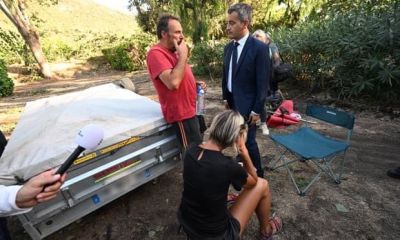Violent thunderstorms with winds of up to 139mph struck the Mediterranean island of Corsica and parts of Italy last month, killing seven people and leaving at least a dozen more injured. Two people were killed in separate incidents in Tuscany when trees were ripped up by storms, one near the city of Lucca and another near Carrara. Another four people were injured by falling trees at a campsite near Carrara. In Venice, high winds detached pieces of brick from St Mark’s bell tower, which stands in front of the famed cathedral. Tourists were evacuated from the structure, which was cordoned off. The storm upended chairs and tables in St Mark’s Square and elsewhere and swept away beach chairs on the nearby Lido. The storms struck after three days of intense rain in the region, which has endured a summer of extreme heat, drought and raging forest fires that scientists have linked to human-caused climate change. In northern Italy, an overnight storm forced the closure of a rail line southeast of Genoa after high winds carried beach structures onto the tracks, damaging the electrical circuitry. The storm struck during Italy’s busiest beach vacation week. The mayor of Sestri Levante, Valentina Ghio, warned that whirlwinds were possible and appealed to visitors to stay away from beaches until the severe weather had passed. Hailstones the size of walnuts pounded Italy’s Liguria region with enough force to break windows and damage orchards and gardens. While northern Italy has suffered its worst drought in decades this year, heavy rains in recent days that brought scattered hailstorms, whirlwinds and flooding have damaged or destroyed entire crops of fruits and vegetables along with vineyards and olive orchards, according to the Italian agricultural lobby Coldiretti.
Le violente tempeste con venti forti che hanno raggiunto oltre 200 chilometri all’ora, hanno colpito il Mare Mediterraneo, in particolare l'isola della Corsica e il nord d’Italia. Purtroppo, sette persone sono morte e almeno dodici persone sono state ferite. Due persone sono morte in Toscana con la caduta degli alberi, una persona era di Lucca e un'altra di Carrara. Quattro persone sono state ferite mentre erano in campeggio vicino a Carrara. Alcuni mattoni sono saltati dalla torre di San Marco a Venezia e le persone hanno dovuto evacuare la zona. La tempesta ha danneggiato anche sedie, tavoli e altre cose nella piazza di San Marco e nel Lido. La tempesta è durata tre giorni. La regione ha sofferto un'estate di caldo estremo, una siccità, e tanti incendi boschivi che gli scienziati dicono siano il risultato del cambiamento climatico causato dall'uomo. Un’altra tempesta al sud di Genova ha costretto alla chiusura di treni ed binari dopo che la pioggia ha distrutto l'impianto elettrico della zona. Valentina Ghio, il sindaco di Sestri Levante, ha avvertito di non andare sulle spiagge prima e durante questo temporale terribile. La grandine (con sassi della misura di una noce) è caduta per tutta la Liguria, distruggendo case, finestre, orti e frutteti. Benché il nord Italia abbia avuto la peggiore siccità da decenni, la pioggia ha causato inondazioni e le tempeste hanno distrutto vigneti, alberi da frutto, orti piante e verdure (secondo un'organizzazione agricola).



